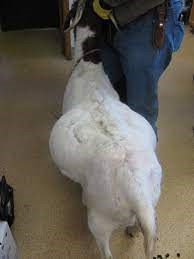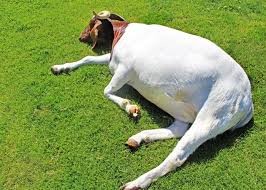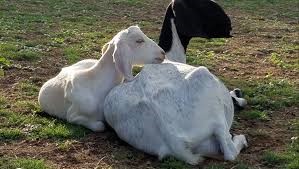HEALTH AND DISEASES
Back
Bloat Introduction
Bloat is one of the common problems encountered with small ruminants. If treated properly and aggressively, most cases have a favorable outcome. Many bloat conditions can be prevented by using proper nutrition and sound management.

 Clinical Signs:
1. A distended abdomen, mostly on the left side, high in the flank area is the most common sign. (If the animal is pregnant and seems to be distended on both sides of the abdomen, special consideration should be given to a possible hydrops animal. If this is a concern, consult a veterinarian.)
2. The animal may have difficulty breathing, extend its neck, and even make grunting sounds.
3. Signs of colic may also be present (kicking at abdomen, getting up and down, etc.).
Clinical Signs:
1. A distended abdomen, mostly on the left side, high in the flank area is the most common sign. (If the animal is pregnant and seems to be distended on both sides of the abdomen, special consideration should be given to a possible hydrops animal. If this is a concern, consult a veterinarian.)
2. The animal may have difficulty breathing, extend its neck, and even make grunting sounds.
3. Signs of colic may also be present (kicking at abdomen, getting up and down, etc.).

 Causative Agents: There are two major categories of bloat:
1. Free-gas/Frothy bloat - This type of bloat can be brought on by diets that cause excessive gas production in the rumen and decrease the rumen pH. Diets high in grains, lush legumes, or winter wheat are causes of this problem. This type of bloat can also be caused by poorly digestible feed material and problems with indigestion.
2. Problems that are outside of the rumen - These include choke and position of the animal.
Treatment:
1. For simple gas and frothy bloat problems, passing a tube into the rumen to relieve gas and fluid is essential. (Information on passing a tube can be found on page C854.) Then liquid dishwashing detergent (10-20 mLs), Therabloat (poloxalene) (5.5 mLs per 100 lbs. of body weight), dioctyl sodium sulfosuccinate (DSS) (15-30 mLs), or another gas-reducing product should be given by drench or stomach tube. If signs of breathing problems and severe distress are present or routine treatment does not relieve the problem, it may be necessary to insert a large gauge needle or trocar into the rumen in the left flank area. Additional instruction may be required to perform this properly (see the following pictures). If grain overload is suspected.
2. Probios or another source of gut flora should also be given.
3. For problems causing bloat outside of the rumen, the underlying cause must be determined and proper treatment begun. Diagnosing these problems may require the help of a veterinarian.
Causative Agents: There are two major categories of bloat:
1. Free-gas/Frothy bloat - This type of bloat can be brought on by diets that cause excessive gas production in the rumen and decrease the rumen pH. Diets high in grains, lush legumes, or winter wheat are causes of this problem. This type of bloat can also be caused by poorly digestible feed material and problems with indigestion.
2. Problems that are outside of the rumen - These include choke and position of the animal.
Treatment:
1. For simple gas and frothy bloat problems, passing a tube into the rumen to relieve gas and fluid is essential. (Information on passing a tube can be found on page C854.) Then liquid dishwashing detergent (10-20 mLs), Therabloat (poloxalene) (5.5 mLs per 100 lbs. of body weight), dioctyl sodium sulfosuccinate (DSS) (15-30 mLs), or another gas-reducing product should be given by drench or stomach tube. If signs of breathing problems and severe distress are present or routine treatment does not relieve the problem, it may be necessary to insert a large gauge needle or trocar into the rumen in the left flank area. Additional instruction may be required to perform this properly (see the following pictures). If grain overload is suspected.
2. Probios or another source of gut flora should also be given.
3. For problems causing bloat outside of the rumen, the underlying cause must be determined and proper treatment begun. Diagnosing these problems may require the help of a veterinarian.
